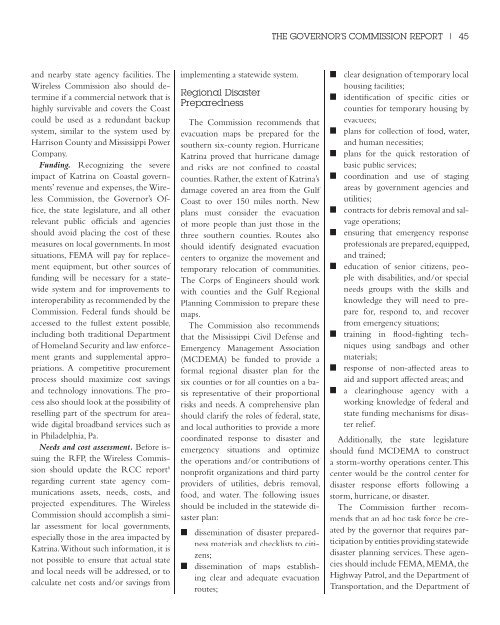Reports - Mississippi Renewal
Reports - Mississippi Renewal
Reports - Mississippi Renewal
- No tags were found...
You also want an ePaper? Increase the reach of your titles
YUMPU automatically turns print PDFs into web optimized ePapers that Google loves.
THE GOVERNOR’S COMMISSION REPORT | 45and nearby state agency facilities. TheWireless Commission also should determineif a commercial network that ishighly survivable and covers the Coastcould be used as a redundant backupsystem, similar to the system used byHarrison County and <strong>Mississippi</strong> PowerCompany.Funding. Recognizing the severeimpact of Katrina on Coastal governments’revenue and expenses, the WirelessCommission, the Governor’s Office,the state legislature, and all otherrelevant public officials and agenciesshould avoid placing the cost of thesemeasures on local governments. In mostsituations, FEMA will pay for replacementequipment, but other sources offunding will be necessary for a statewidesystem and for improvements tointeroperability as recommended by theCommission. Federal funds should beaccessed to the fullest extent possible,including both traditional Departmentof Homeland Security and law enforcementgrants and supplemental appropriations.A competitive procurementprocess should maximize cost savingsand technology innovations. The processalso should look at the possibility ofreselling part of the spectrum for areawidedigital broadband services such asin Philadelphia, Pa.Needs and cost assessment. Before issuingthe RFP, the Wireless Commissionshould update the RCC report 6regarding current state agency communicationsassets, needs, costs, andprojected expenditures. The WirelessCommission should accomplish a similarassessment for local governments,especially those in the area impacted byKatrina. Without such information, it isnot possible to ensure that actual stateand local needs will be addressed, or tocalculate net costs and/or savings fromimplementing a statewide system.Regional DisasterPreparednessThe Commission recommends thatevacuation maps be prepared for thesouthern six-county region. HurricaneKatrina proved that hurricane damageand risks are not confined to coastalcounties. Rather, the extent of Katrina’sdamage covered an area from the GulfCoast to over 150 miles north. Newplans must consider the evacuationof more people than just those in thethree southern counties. Routes alsoshould identify designated evacuationcenters to organize the movement andtemporary relocation of communities.The Corps of Engineers should workwith counties and the Gulf RegionalPlanning Commission to prepare thesemaps.The Commission also recommendsthat the <strong>Mississippi</strong> Civil Defense andEmergency Management Association(MCDEMA) be funded to provide aformal regional disaster plan for thesix counties or for all counties on a basisrepresentative of their proportionalrisks and needs. A comprehensive planshould clarify the roles of federal, state,and local authorities to provide a morecoordinated response to disaster andemergency situations and optimizethe operations and/or contributions ofnonprofit organizations and third partyproviders of utilities, debris removal,food, and water. The following issuesshould be included in the statewide disasterplan:■ dissemination of disaster preparednessmaterials and checklists to citizens;■ dissemination of maps establishingclear and adequate evacuationroutes;■ clear designation of temporary localhousing facilities;■ identification of specific cities orcounties for temporary housing byevacuees;■ plans for collection of food, water,and human necessities;■ plans for the quick restoration ofbasic public services;■ coordination and use of stagingareas by government agencies andutilities;■ contracts for debris removal and salvageoperations;■ ensuring that emergency responseprofessionals are prepared, equipped,and trained;■ education of senior citizens, peoplewith disabilities, and/or specialneeds groups with the skills andknowledge they will need to preparefor, respond to, and recoverfrom emergency situations;■ training in flood-fighting techniquesusing sandbags and othermaterials;■ response of non-affected areas toaid and support affected areas; and■ a clearinghouse agency with aworking knowledge of federal andstate funding mechanisms for disasterrelief.Additionally, the state legislatureshould fund MCDEMA to constructa storm-worthy operations center. Thiscenter would be the control center fordisaster response efforts following astorm, hurricane, or disaster.The Commission further recommendsthat an ad hoc task force be createdby the governor that requires participationby entities providing statewidedisaster planning services. These agenciesshould include FEMA, MEMA, theHighway Patrol, and the Department ofTransportation, and the Department of




